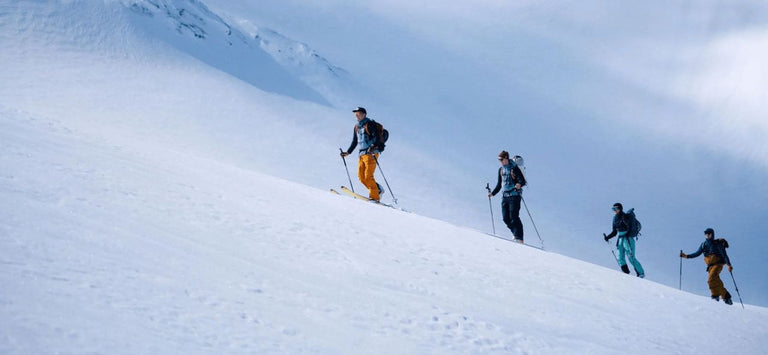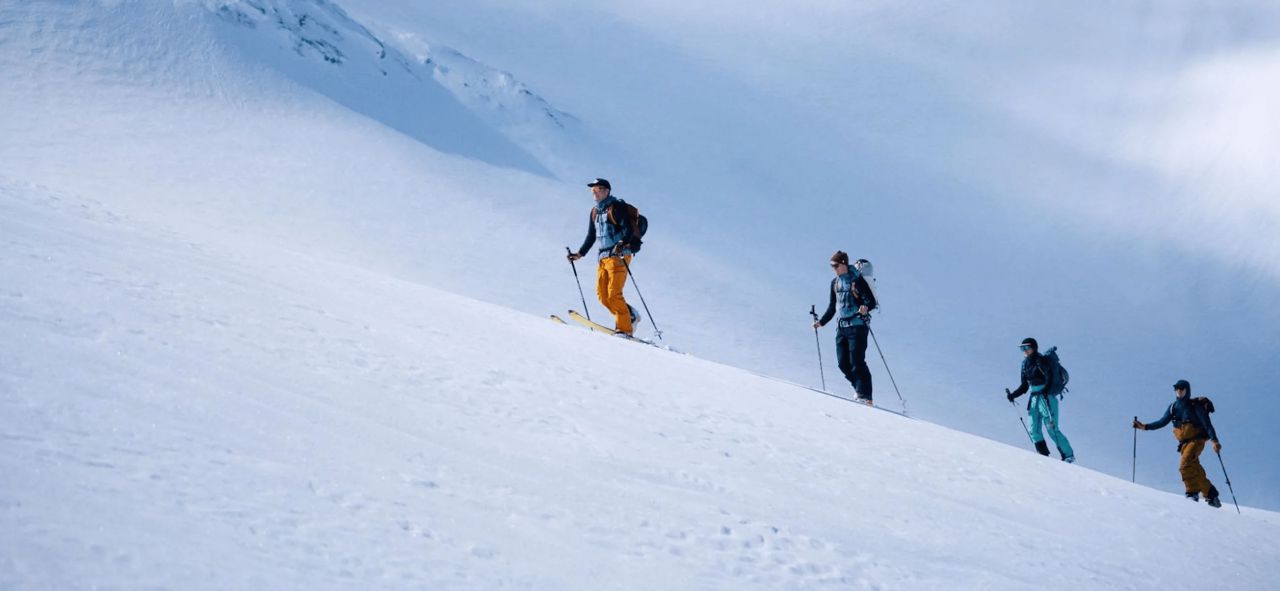So, heading into the backcountry has piqued your interest, huh? We can’t blame you; it’s fun, it’s fulfilling, and from all of the footage found all over social media it looks to be full of pow turns, epic views, and pure dream-like moments.
But before you grab your gear and start walking up to a summit, it’s best to take a moment to cover the basics. The reality is that, while backcountry skiing and splitboarding are an incredible way to get out to new places and enjoy nature, this niche of a sport can be very dangerous and should be treated with the utmost respect - and it comes with a lengthy list of gear, courses, and safety considerations that should always be taken seriously.
“Chairlifts are fun, there is no question about it. However, skiing at a resort limits your ability to experience the mountains. There is a special zen-like state that comes from touring in the mountains that exposes a whole different side of skiing.” - Peter Bollenbacher, TREW Ambassador

*Please note that this article will just scratch the surface of the plethora of information out there about backcountry skiing and splitboarding - and in no way does this article take the place of getting formal backcountry + avalanche education from a licensed provider!
1. First, let’s lay the foundation.
The backcountry is not the place to learn how to ski or snowboard; for both safety and the sake of enjoyment, have a solid ability on planks before taking to the backcountry. Spend some time at the resort becoming a proficient rider, and only work your way into the backcountry when you have the confidence to leave the mellow groomers behind. With the proper foundational skills, you will have a much better time - and, even more importantly, you will keep both yourself and your backcountry partner(s) safer while in dangerous terrain.
2. Find a good friend (or group of friends) with experience who can help you get started.
You’ve likely found that there is a LOT of information to be found online about all sorts of backcountry topics, and within those wormholes there are a lot of opinions - many right, some wrong, but all of them said with some amount of authority. Navigating the onslaught is tough, and oftentimes overwhelming, but having a good friend (or group of buddies) who you trust and can feel comfortable with will help tremendously.
These people will help guide you through the very first steps to entering the backcountry world, and will soon become your backcountry partners for your first tours - so picking the right people, whom you trust, feel comfortable with and confident in, and enjoy spending time with, is crucial! Someone who is good at coaching, guiding, and teaching will be best suited for this sort of role in your life; despite the best of intentions, sometimes a certain friend may not be the best guide for you if they make you feel bad about yourself, pressure you into certain situations, or generally take the fun out of very step.

3. Set your expectations low to start - and build up from there.
It’s easy to see videos and photos of friends, out there summiting new peaks every day seemingly without breaking a sweat. But before you embark on your first escapade, you should know a few things:
4. Backcountry skiing + snowboarding is hard!
Even those doing it for years can struggle at times, and when just starting out this can feel like a literal uphill battle between you and - well, everything. Your new gear, the terrain, the snow conditions, the sheer amount of work. It’s hard work, and it takes time to get accustomed to the new muscles you’re using, the new gear you’re traveling with, and everything else that’s going on.
“Patience with yourself and others is key to keeping a positive mindset with touring. It’s a really hard activity! And it’s important to recognize it’s difficult and be proud of your body for how hard it’s working to get you uphill. I like to be honest and open with my touring partners if I’m feeling low energy or not as in shape for our hike, and that I’m glad to set a slower pace or take more breaks. Good friends should totally get that and not put pressure on you to push your physical boundaries. It is also possible to start off your touring experience with some more mellow adventures with shorter mileage and less elevation gain, that way you’re easing into it instead of having your first tour be a suffer fest and taint your perspective on it all together. “ Rachel Lightner, TREW Ambassador
5. Get the right gear for you - and even more important, become comfortable with it + confident in your skills.
We’ll stay away from getting too granular on what you need specifically, and what brand or model of each is ‘best’; this is more of PSA that, whatever gear you end up getting, renting, or borrowing, you should know how to use it well before you start hiking away from the parking lot.
This is especially important for you avalanche safety gear - your transceiver/beacon, your probe, and your shovel. These three items are something that every single person entering avalanche terrain should have on them and be well-practiced with. Consider these three items to be your lifeline, as they will be the most important tools in the case that anything goes wrong out there.
*This sport is expensive! So before you shell out a buttload of cash on brand new equipment, it’s always a good idea to make sure that you actually enjoy it first. Rent (or if you’re lucky, borrow) some gear, grab your friend(s), and head out to a safe area - somewhere either out of avalanche terrain in very safe conditions, or within resort boundaries if they have an uphill policy - and try it out! Try hiking in the boots and bindings while using the skins, transition from hike mode to ski mode, and then point your tip(s) downhill. Keep it short, and very conservative, since you don’t have any avalanche training at this point – but it’s well worth giving the sport a test run before you begin investing a larger amount of time and cash into it.
6. Begin your education.
We don’t expect you to know everything before you step foot on that fresh pow, but having a good sense of what you should be looking for, thinking about, and considering while in the backcountry is a good place to start from. With the help of that same friend we mentioned above, get yourself working on some of the basic education around backcountry best practices and avalanche safety. 
There are a huge amount of resources to help you get started, both online and in person, free and paid, that can make this process even more enjoyable and give you the learning setting that you desire. Coed or all-female, big groups or small, there’s bound to be something available that will be perfect for you. You can always check in with your local ski shop as well to see if they have any events coming up, or know about any Intro to Backcountry opportunities near you.
It’s also worth noting here that your education in the backcountry will never end, and every day out, every season in the backcountry will bring with it new learning and new opportunities to build your knowledge and skills. This is just the start!
“Check out your local avalanche center and see if there are any webinars/seminars they offer. It's great to start learning about snowpack if you're interested in getting into Backcountry Skiing. Before taking your Avy 1 Certification, which involves fieldwork and skiing, you should be comfortable and confident in your skiing abilities. There's lots of space to nail your equipment and the logistics of touring once you're in the class, so don't let being a beginner at touring stop you. (For my fellow women, I recommend an all-women's course-- it's a game changer).” - Erica Aarons, TREW Ambassador
7. Remember, it’s okay to suck!
No one has ever jumped right into backcountry skiing or splitboarding and automatically picked it up with no issue. There’s a lot going on here - from those weird new bindings and sticky skins, to long climbs up seemingly impossible hillsides, all the way to the daunting amount of things to know, think about, and be aware of all the time. Start small, be smart, and have some fun!
It’s also okay to not be into it: to each their own! As our ambassador Dylan Dipentima reminded us recently, 90% of your time is spent going uphill to enjoy the 10% that is downhill. Those who stick with it find a huge amount of fulfillment in the uphill, but it’s okay if you try it and find that it just isn’t for you.
Buckle up, it’s going to be a fun ride…and it’s just getting started! For the next leg of your backcountry journey, keep an eye out for our next article diving into the world of backcountry gear (dropping on 11/10/22) - from the hardgoods like skis and boards, to packs, insulation, first aid, and of course avalanche safety gear.
And if you are ever in search of the perfect outerwear - jackets, pants, bibs, and more - to keep you comfortable on your backcountry adventures, we at TREW would love to be the ones to get you kitted!

This article was written by TREW Gear, a backcountry-focused outerwear company based in Portland, OR. TREW believes that people who have positive experiences in the mountains are better stewards for the environment, happier people in their communities, and more motivated to make the world a better place. Thus, they spend all of their time working to make the best gear to keep the good times rolling - for everyone!
TREW Gear and Gnarly Nutrition are teaming up to make this your best season yet! To celebrate this partnership, use the code TREWLYGNARLY to get 20% off select outerwear from TREW Gear AND 20% off your next order with Gnarly!
#stayTREW #PushYourPossible
Images by Zoya Lynch.




